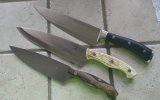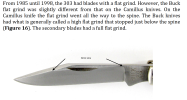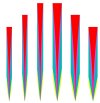This will be fun...
Generally speaking... I prefer hollow grinds in my hunting knives. I won't go in to the "why" because it should be obvious. This would be for field care, not necessarily meat processing. So dreassing and breaking into primals.
I generally prefer flat grinds in my kitchen knives and processing knives.
For EDC, I dont really have a preference, but more of my folders for carry are hollow while more of my fixed blades are flat. I think its merely a coincidence that is the case.
Here's the rub... blade cross section and the geometry associated is what I struggle with.
For instance... If you have a blade height of say 1.25", and you have a flat grind that is only .625", you will have a more obtuse/thicker blade cross section than if you would grind the full 1.25", so in the case where you arent grinding the full blade height, I usually prefer a hollow grind.
Here's a real head scratcher for me. A hollow ground chef knife sounds like a good idea. Thin, lean profile should be good and slicy.
And it is... unless you're slicing blocks of cheese, potatoes, or anything else thats more than about an inch thick with little give.
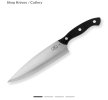
Compare that to a flat ground blade from spine to the cutting edge and you'll scratch your head too.
I love the idea of my elk handled kitchen set, but I dont love them. I actually like the BOTM kitchen knives better than the elk set. They all slice exponentially better than the elk set. At some point I'll pack them up and let someone else love them.
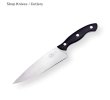
I will say that neither hold a candle to my Wusthoff set, but I do like using the BOTM knives.
Got well off topic, but I'm bored, and you asked....
